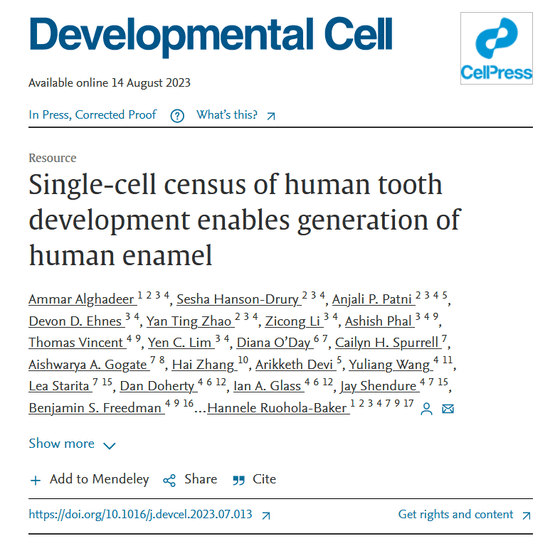Succeeded in regenerating tooth enamel using stem cells, expected to realize caries regeneration technology

Teeth are made of enamel, dentin, and cementum, and enamel covering the crown exposed from the gums is one of the hardest tissues in the human body. However, this enamel is easily dissolved by the acid produced by
Single-cell census of human tooth development enables generation of human enamel - ScienceDirect
https://doi.org/10.1016/j.devcel.2023.07.013

No More Cavities? Organoids Pave the Way for Enamel Regeneration
https://scitechdaily.com/no-more-cavities-organoids-pave-the-way-for-enamel-regeneration/

Enamel is made by cells called ameloblasts . However, since the ameloblasts die after completing the formation of enamel, there is almost no way to repair or regenerate the enamel even if it is damaged by caries, etc., and it is remineralized by minerals contained in saliva. I have no choice but to rely on.
Therefore, the research team adopted an analysis technique called 'single-cell combinatorial indexing RNA sequencing (sci-RNA-seq)' that reveals which genes are active at various stages of cell development. This technology reveals which genes are active at which stage from changes in mRNA at various stages of cell development. We will investigate what genes are activated at which stage when undifferentiated stem cells differentiate into tooth-forming cells, and investigate which genes are activated to differentiate into ameloblasts.
The image below is a cross-section of a developing tooth, and the colors identify which genes are expressed at each stage of development.

The research team succeeded in inducing undifferentiated human stem cells from the results of sci-RNA-seq and differentiating them into ameloblasts. At the same time, we report that we have identified the precursors of odontoblasts that form dentin for the first time.
By inducing these cells together, the research team successfully formed small multicellular tissues called ' organoids '. These organoids were found to secrete three enamel proteins: ameloblastin , amelogenin , and enamelin . They also confirmed the calcification process for these enamel proteins to form an extracellular matrix and become enamel.

The research team is investigating a more efficient process to form enamel with a hardness comparable to that of natural teeth. He says he hopes to develop a method to repair damaged enamel with this artificial enamel in the future. If this process is put into practical use, it may be possible to create bio-derived fillings for teeth that have melted or have holes due to caries, etc., and stem cell-derived teeth that replace lost teeth. I may be able to make it.
Professor Hannelle Ruohora-Baker, the final author of the paper and deputy director of the University of Washington Institute for Stem Cell and Regenerative Medicine, said, 'Large and complex organs such as the human pancreas, kidneys and brain cannot be safely regenerated from stem cells. It takes time, on the other hand teeth are much smaller and much less complicated and it's probably easier to achieve results, it may take a while before we can regenerate the teeth, but we're doing it Now that we have seen the steps necessary to do so, the 'century of bio-derived fillings' has finally arrived, and regenerative dentistry that can be used by the general public may begin.'
Related Posts:
in Science, Posted by log1i_yk







